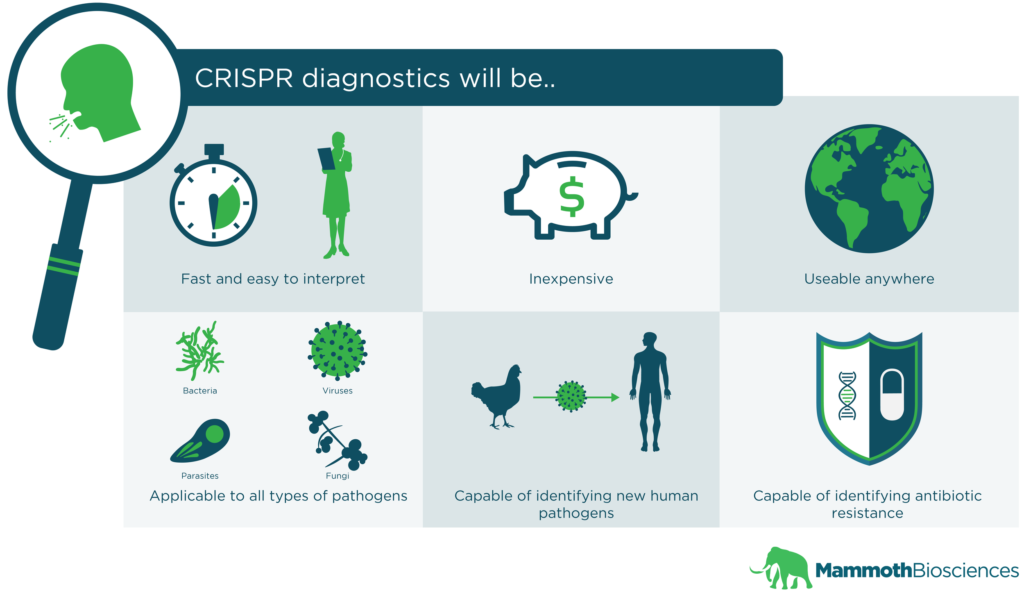Tyler Ford
11/07/2019
Millions of people die from infectious diseases each year. These diseases are caused by organisms and viruses (pathogens) that colonize and parasitize our bodies. Indeed, many different pathogens cause many different diseases. While these often come with similar symptoms, they must be treated in different ways.
CRISPR diagnostics (CRISPR Dx) will provide us with fast and inexpensive ways to identify pathogens. Accurate pathogen identification will empower physicians to effectively treat infectious diseases. As you’ll learn below, the rise of antibiotic resistance and climate change make it more important than ever to develop rapid and effective CRISPR Dx.

Learn how “Point-of-Need” diagnostics will help us fight COVID-19
The causes of and growing dangers of infectious disease
Many different pathogens cause infectious diseases. Bacteria, parasites, fungi, and viruses can all invade our bodies and make us sick. Tuberculosis, for example, is a devastating disease caused by the bacterium Mycobacterium tuberculosis. In 2016, roughly 1.5 million people died from this disease. The seasonal flu, on the other hand, is caused by a virus. It kills between 290,000 and 650,000 people annually. Malaria is caused by 4 different species of parasite (plasmodium). It is spread by mosquitoes and killed roughly 450,000 people in 2017. Finally, the fungus Candida auris causes a highly deadly infection. There were 799 cases reported in the US as of September 2019. Candida auris infections kill >30% of those infected.
In the last century, antibiotics have saved us from the scourges of many bacterial infections. Yet, antibiotics are useless against other kinds of pathogens.
In addition, slow and inexact diagnostics have led to the overuse and misuse of antibiotics against non-bacterial pathogens. Importantly, we do have means of treating non-bacterial infections. We have antivirals for viruses, antifungals for fungi, and various drugs for parasites. Yet, it is often difficult for doctors to identify which of these pathogens is causing an illness. Thus the wrong drugs are often used. Not only does this fail to help patients, it also enables pathogens to develop resistance. In the U.S. alone, antibiotic resistant infections cause 35,000 deaths a year.
Worse still, infectious diseases are reaching new people in new places. There are a variety of reasons for this, but climate change is hypothesized to have a major role. Warmer temperatures allow the critters that spread diseases like Lyme Disease to move into new geographic locations where they can infect more people. Indeed, it’s even hypothesized that climate change enabled Candida auris to begin infecting humans.
Ideal infectious disease diagnostics
Good diagnostics enable physicians to identify pathogens and prescribe effective drugs.
Traditionally, physicians have identified pathogens by growing them in labs and staining them with various compounds. These techniques were huge improvements when they were first developed. Yet, they can take hours to days to complete. This is too long for many infectious diseases. These techniques can leave patients in dire straights. They also aren’t useful for for all pathogens.
To replace these older diagnostic technologies, ideal diagnostics should be:
- Fast (get results in <1h) and easy to interpret
- Inexpensive
- Useable anywhere
- Applicable to all types of pathogens
- Capable of identifying new human pathogens
- Capable of identifying antibiotic resistance
Nucleic acid detection for infectious disease diagnosis and the benefits of CRISPRDx
While the lifestyles of different pathogens vary widely, they all have genetic material. All pathogens use either DNA or RNA (nucleic acids) to encode their component parts. Indeed, the nucleic acids found in particular pathogens are specific to those pathogens. Thus, if physicians can look at a pathogen’s nucleic acids, they can identify the pathogen. By looking at nucleic acid sequences encoding resistance, physicians can also determine which drugs will actually kill a pathogen. Then they can prescribe effective drugs.
Indeed, many new nucleic acid-based diagnostics have at least some of the characteristics of ideal diagnostics. Unfortunately, they often require extensive expertise to use. They can also be expensive.
CRISPR Dx, on the other hand, will have all the characteristics of ideal infectious disease diagnostics. They will produce clear signals when a pathogen’s nucleic acids are present. They will also be adaptable to new pathogens. They will be inexpensive/disposable and should be easy to use on various kinds of patient samples. We should be able to deploy them all over the world.
In addition, CRISPR Dx will be especially useful in the resource-poor regions where infectious diseases have been particularly devastating. These regions often lack extensive healthcare infrastructure. While other nucleic acid-based diagnostics might be difficult to deploy in these regions, CRISPR Dx should be useable directly at the point of care. Thus, CRISPR Dx will be a huge boon to health care providers in these regions.
CRISPR Dx will help shore up our first lines of defense against infectious disease. They’ll make it so doctors can quickly prescribe the appropriate treatments all over the world. We hope they’ll stop outbreaks and prevent the drug misuse that leads to resistance.
Interested in joining the Mammoth team? Check out our open positions!
Learn about our CRISPR-based SARS-CoV-2 detection platform for commercial labs!
